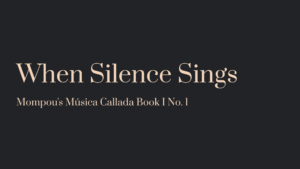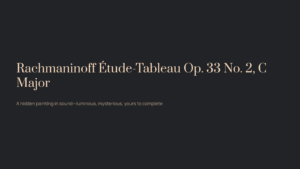Table of Contents

An Imperfect Perfection Born from Darkness
When I first heard this music, I felt as though I was glimpsing only a fragment of something immense. Like the half-standing columns of an ancient temple, beautiful yet carrying somewhere the melancholy of incompletion. Schubert’s Symphony No. 8 “Unfinished” entered my heart in just this way and found its place there.
When the cellos and double basses open the door with their mysterious melody, as if rising from an underworld, we already stand at the starting point of an extraordinary journey. This music possesses a paradoxical beauty—perfected precisely because it was never completed.

A Revolution Born at the Boundary of Eras
A 25-Year-Old Genius’s Bold Experiment
In 1822, when the 25-year-old Schubert wrote this symphony, the musical world stood at the center of tremendous change. It was the era when Beethoven’s Symphonies No. 7 and 8 had just been premiered, when the perfect architectural structures of Classicism still dominated. Yet Schubert boldly chose a different path.
Even his choice of B minor was telling. This “dark key,” rarely used in symphonies of the time, carried the heavy coloration that Beethoven called it. In Schubert’s lieder, this key always symbolized “mourning, sorrow, the grave, melancholy.” To dress such intimate emotional colors in the grand form of a symphony—this was a small revolution.

An Emotional Map Drawn in Sound
The First Door: Whispers from the Underworld
The moment the first movement begins, we step into a strange space. The introduction—8 bars of unison cellos and double basses played pianissimo—sounds like a voice “emerging from the underworld.” When I first heard it, I had no idea this brief melody would become the key that unlocks the entire movement.
Conductor Weingartner described this passage: “As if from the underworld, Schubert’s melody seems to well up and flow into this world.” These words resonate strangely with me. There’s something like a mystical chemical reaction that occurs at the boundary where music rises from some deep place to meet our reality.
The Second Door: A Tender Confession
After the introduction, as the violins lay down their anxiously trembling accompaniment, oboe and clarinet enter above. The first theme they play is truly a “pleading” melody. Here Schubert’s distinctive talent shines. He was a genius at creating melodies—not through complex harmony or clever counterpoint, but through songs that naturally draw the heart along just by listening.
This theme contains tonal uncertainty and chromatic coloration. Where traditional Classicism would have presented a clearer, more stable theme, Schubert deliberately chose ambiguity. This was the beginning of Romanticism.
The Third Door: A Dance of Hope
Then the second theme emerges in G major, opening an entirely different world. This melody, played by the cello, resembles the rhythm of the Ländler, an Austrian folk dance. In complete contrast to the dark, heavy first theme, it flows with bright, singing beauty.
It’s no coincidence that this melody was later borrowed for operetta, or that some note similarities to Korean children’s songs. Schubert’s melodies possess such universal, intuitive beauty. They have the power to reach the heart directly, without complex explanation.

My Experience of Unfinished Completion
Finding His Own Path While Trying to Surpass Beethoven
In the development section, Schubert attempts Beethoven-style motivic development—that method of gradually building tension using a single small motif. But something curious happens here. Rather than developing logically like Beethoven, Schubert’s music reveals its own charm through repetition and variation of beautiful melodies.
Some musicologist reportedly criticized this as a “failure in developmental technique,” but I find Schubert’s essence in precisely this quality. There was no need to force imitation of Beethoven. Schubert had his own method.
An American scholar proposed the hypothesis that Schubert left this symphony unfinished because he failed in attempting to imitate Beethoven’s logical development. After Beethoven, the center of gravity in symphonies shifted to the finale, requiring consistent logic from first to fourth movement—perhaps too difficult a challenge for Schubert.
But this makes it even better. If Schubert had insisted on copying Beethoven to the end, we might never have heard this unique and beautiful music we know today.
The True Completion Brahms Saw
Brahms left remarkable words about this work: “This symphony is certainly unfinished in terms of form, but it is by no means unfinished in content. Both movements are rich in substance, and their beautiful melodies capture the human soul with endless love, so that no one can help but be moved.”
These words are precise. Something completed by being unfinished—such paradox exists in this music. If Schubert had forced himself to add third and fourth movements, could he have left the perfect resonance we experience today?

Three Ways to Listen More Deeply
First, Notice the Return of the Introduction
When listening to the first movement, remember that mysterious melody of cellos and double basses at the very beginning. Simply tracking how this melody reappears throughout the movement makes the music sound far more three-dimensional. There’s a pleasure like solving a cipher.
Second, Listen to the Woodwind Dialogue
Schubert uses woodwinds more prominently than strings. Listen to the conversations between oboe, clarinet, and flute. They appear—sometimes solo, sometimes in harmony—at crucial moments to change the emotional coloration.
Third, Trust the Power of Repeated Listening
Schubert’s music cannot be fully felt in a single hearing. His melodies possess “completed beauty,” revealing new aspects with each repeated listening. Don’t rush to analyze—just surrender yourself to those beautiful melodies.

A Record of Encounters Across Time
On December 17, 1865, when this music was first performed publicly, the Viennese audience had a special experience. When the oboe and clarinet played that sweet melody, people whispered to each other, “It’s Schubert.” And “joy filled the audience as if Schubert had returned from a long journey and stood among us.”
I understand that joy. A composer who had been dead nearly forty years was there beside us again through his unfinished music. And that music, crossing the boundaries of time, creates new beauty between past and present, Classical and Romantic, finished and unfinished.
Schubert’s “Unfinished” ultimately proves the power of music to transcend time. This music quietly whispers that there are things more important than formal completion, that sometimes the unfinished can be the most perfect form. That whisper continues to reach our ears across more than 150 years.

Next Destination: Bartók’s Wild Completion
Having listened to Schubert’s lyrical incompletion, let us now journey to a completely different world. The fourth movement “Interrupted Intermezzo” of Bartók’s Concerto for Orchestra shows us another form of completion that 20th-century music achieved.
If Schubert found a new path between Classical and Romantic, Bartók created his own language between Eastern European folk music and modern techniques. Especially in the fourth movement, the primitive energy of Hungarian folk songs meets sophisticated orchestral technique, revealing explosive vitality.
When a heart soaked in Schubert’s introspective beauty encounters Bartók’s dynamic rhythms, we realize anew how broad the spectrum of emotions music can embrace. From the resonance of incompletion to completed energy, from 19th-century dreams to 20th-century reality—isn’t this what true musical journey means?



